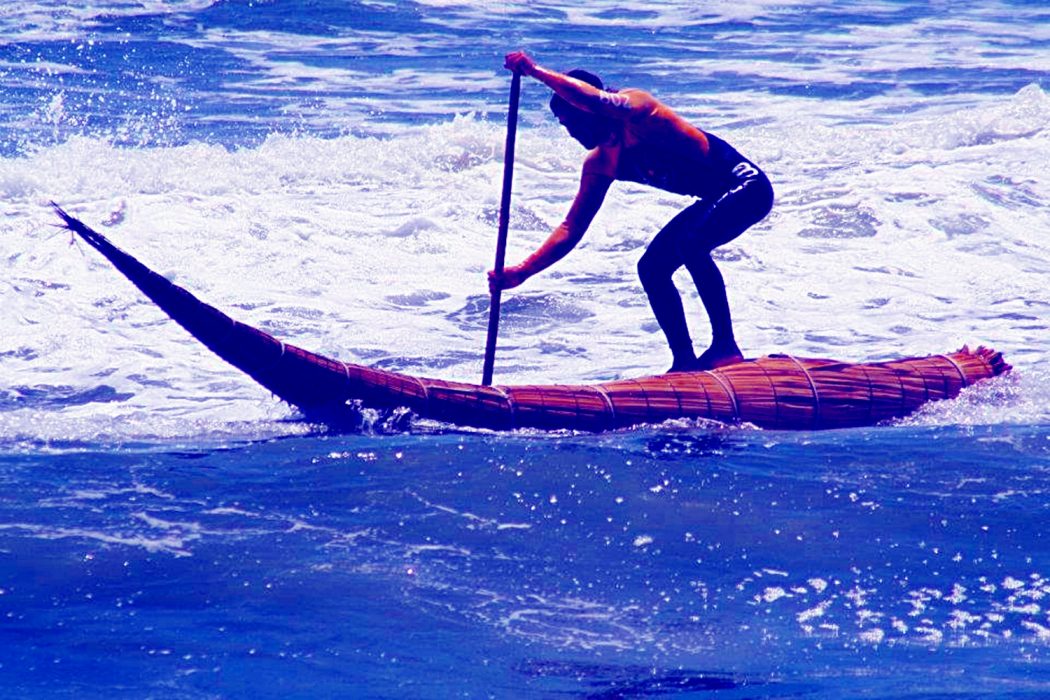Lately, more and more activities and customs are being labeled cultural appropriation: music, food, even language. As I prepared for my annual trip to the beach, intent on learning how to surf (this year I will show improvement), I remembered the little I knew about surfing’s history—namely, its roots in Polynesian Indigenous culture—and suddenly thought: are sports next? Where do we draw the line between cultural appropriation, cultural appreciation, and cultural exchange? How should sports with religious or spiritual roots in Indigenous culture, such as surfing, lacrosse, martial arts, and yoga be understood in the twenty-first century?
The original form of surfing originated in ancient Polynesia, where fishermen would stand on planks of wood and paddle out to catch fish. From there it developed into a pastime of its own, with people venturing into the sea just for the thrill of riding the waves. This practice was also observed in studies of pre-Incan Peruvian societies—as part of the Mochica culture—as a fishing method and possible leisure activity.
Contemporary surfing saw its inception in pre-colonial Hawaii, where the best beaches and surfboards were claimed by the elite class. Religious aspects of surfing included prayers to deities to calm the ocean’s waves, as well as rituals in surfboard construction. There were only three designated types of trees from which one species would be selected. The surfer would then dig up the tree and place fish in the hole as an offering to the gods—in exchange for the tree—before carving began. At the time, Hawaiian society was strictly divided into social classes, but skill in surfing became a way for both royalty and commoners to gain respect.
The popularity of surfing declined after Hawaii encountered European colonization; the native population decreased as Western-brought diseases like smallpox ravaged the islands. Western colonizers took over land to create sugar plantations and brought in labour from Asian nations like Japan, China, and the Philippines. Eighty percent of the native population was gone by the 1850s. Missionaries discouraged any custom with ties to a religion other than Christianity, which included surfing and hula dancing. In 1887, the Hawaiian kingdom was essentially forced to become a constitutional monarchy, largely due to anti-monarchist American influence. The new constitution not only limited the power of King Kalakaua but also stripped most native Hawaiian and Asian citizens of their voting rights by instituting high property, income, and literacy requirements, creating a system that privileged white American men. The U.S. annexed Hawaii in 1898, and it was a territory until admitted as a state in 1959.
Surfing was introduced to the U.S. in the latter half of the nineteenth century in California, Florida, and the East Coast. It went mainstream in the 1950s, when surfing became popular among teenagers, and gave rise to Surfing Magazine and artists like The Beach Boys. Hawaii continues to compete separately from the rest of the U.S. in surfing competitions, because many early competitions excluded Hawaiians. Indeed, Native Hawaiians have not been given the official recognition other Native American nations have. The Akaka Bill, a proposal to establish federal recognition of the Native Hawaiians, has never passed Congress, and is opposed by many Indigenous groups who believe the law does not go far enough.
Many suggest that the best way to engage in non-appropriate efforts is through financially remunerating the local culture whose customs are being practiced by outsiders.
Cultural appropriation is defined as “the acknowledged or inappropriate adoption of the customs and practices of one people or society by members of another (typically more dominant) people.” In contrast, cultural exchange is an activity where members of different societies “share mutually with each other.” Surfing’s historical disequilibrium between those who invented it and those who adopted it is clear. But considering all the possible power dynamics, not just between races, but also between genders, religions, sexual orientations and socioeconomic positions—and the ever-increasing amount of things people find offensive—finding a valid example of cultural exchange seems extremely unlikely.
Does this mean that no one should engage in any kind of cultural exchange because someone might find it offensive? Who decides whose opinions make the consensus around whether something is okay or criticized – and whose opinions are ignored? Native Hawaiian Duke Kahanamoku, for example, actively shared surfing with Australians and campaigned for many years so it could be included in the Olympics. Would the Australian custom of surfing be considered appropriative if other native Hawaiians at the time opposed the spread of surfing?
Many suggest that the best way to engage in non-appropriate efforts is through financially remunerating the local culture whose customs are being practiced by outsiders. In this case, this could mean choosing to surf in Hawaii, as your money would support the state’s tourist industry and local businesses. Except many Hawaiians dislike when tourists come to steal their waves; surf gangs even police areas with good waves, sometimes escalating into violence.
True, many issues raised by those who call out cultural appropriation don’t apply their criticism to professional sports. Athletes don’t play sports just to be on trend or to be cool or to make money; sports are enjoyable and healthy. Restricting who can take part in a culture becomes much more problematic with sports.
Native Hawaiians—who are disproportionately homeless, in prison, and of lower income—cannot afford to participate in their own culture.
Perhaps it’s better to understand surfing through the more general trend of commercializing sports to compete in the entertainment industry. Professional sports became more profitable and popular through the invention of the television and the commercialization of the Olympics in the 1970s. Surfers don’t earn money on the same level as soccer or football players, but often commercial sponsors allow surfers to make a profit off of their passion. However, the commercialization of surfing has made it more expensive – surfboards are no longer made of wood, and ones that win competitions cost a lot. Native Hawaiians—who are disproportionately homeless, in prison, and of lower income—cannot afford to participate in their own culture.
The fact is, people are suffering under a system that is deeply flawed. And it’s important for people with privilege to recognize that Indigenous populations have an unequivocal right to participate in their own customs and traditions. But would slapping on a label of cultural appropriation to sports do anything to change this system for the better?
The hypersensitivity of some, the denial of others, and confrontational aspects of the social justice culture itself make cultural appropriation a difficult conversation to have. It raises more questions than it answers—however important those questions may be—with no solution in sight. But whatever the thin line, the world would be a lesser place without cultural exchange. What matters is striking the right balance so Indigenous populations can feel like they are equitable members of this exchange.








